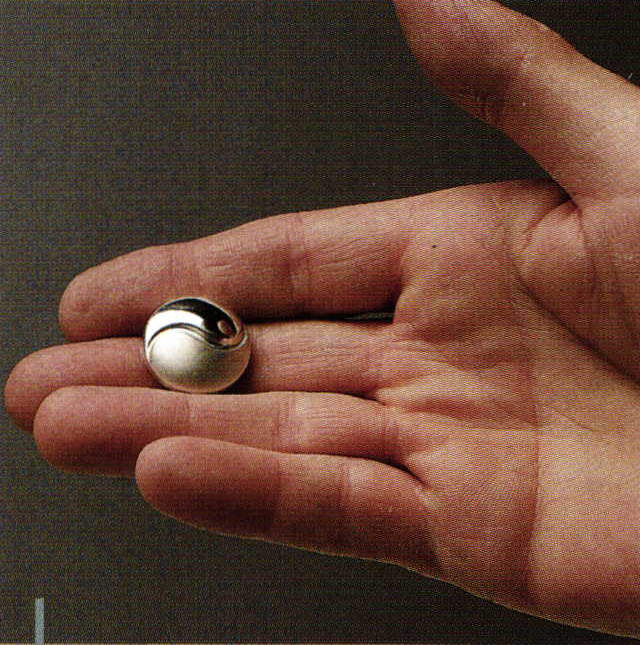Practical Course in Goldsmithing
2 Minute Read
A micro-waterjet device can be used to achieve fine matt finishes on precious metal surfaces. Parts required for this are: jet or wet lap hammer; slow-running compressor, vacuum apparatus, and pressure sprayer (Figure 1).
Fine-grain material is poured into the chamber (fine glass beads up to a grain of 50 p). An adhesive strip is laid over a polished silver plate (Figure 2). This process works with any other metal as well. Water pressure is controlled by the pressure sprayer. There should be an approximately 10-15 cm (3.9-5.9 in.) distance between the nozzle and the object. Slight flooding with the jet is sufficient (Figure 3).
A quick dip into (white) spirit does not only clean any residue from the surface, but also allows it to dry quickly and without spots. The result is a flawless, finely spot-matted finish. Other surfaces, such as wires or tubes, can also be matted in this way (Figure 4). The micro-waterjet device makes this much less problematic than is the case with matt-finish mats. A surface given such a spot-matt finish is considerably less susceptible to dirt, and curved surfaces also appear optimal after this treatment. The composition of the glass beads determines the surface:
0 - 50 µ = especially fine,
40-70 µ =very fine,
70-110 µ =fine.
Subsequently rinsing the object in spirit and drying it with a paper towel results in a surface free of oil. For the goldsmith, it is important to polish the surface beforehand (Figure 5).
A further advantage: if, for example, a pendant is to be given a matt finish on half its surface, a finely drawn spot-matt finish can be applied without having to cover the polished half (Figure 6).
Moreover, jewelry pieces set with stones can be given a flawless spot-matt surface without covering the stones, even if the setting is platinum (Figure 7).
The ancient goldsmithing hammered inlay technique is another way to obtain surfaces with refined structures. First, the extraneous parts of the piece, those which do not fit into the overall creative concept, are sawed off. The slight waved line that was drawn on earlier is then traced with a diamond-tipped cutting bit (Figure 8) A flat graver is then used until the wire inside can be inserted by about 75%, according to its diameter The wire to be inlaid is bent to match the line and worked into the palladium, silver or gold surface (Figure 9).
It is important that the material being inlaid be softer than the basic material. It is pushed in with a hammer. Engraved channels are created with the hammered inlay technique. Then the finishing and refining work with the file can begin (Figure 10).
Equally interesting surface designs can be attained by using a diamond-tipped cutting bit (Figure 11).
Practical-Series Goldsmith 1-12
The latest techniques presented in a series of clear illustrations and informative texts. Available at the Ruehle-Diebener-Publishing.
by Wilfried Schafer
You assume all responsibility and risk for the use of the safety resources available on or through this web page. The International Gem Society LLC does not assume any liability for the materials, information and opinions provided on, or available through, this web page. No advice or information provided by this website shall create any warranty. Reliance on such advice, information or the content of this web page is solely at your own risk, including without limitation any safety guidelines, resources or precautions, or any other information related to safety that may be available on or through this web page. The International Gem Society LLC disclaims any liability for injury, death or damages resulting from the use thereof.
The All-In-One Jewelry Making Solution At Your Fingertips
When you join the Ganoksin community, you get the tools you need to take your work to the next level.
Trusted Jewelry Making Information & Techniques
Sign up to receive the latest articles, techniques, and inspirations with our free newsletter.



